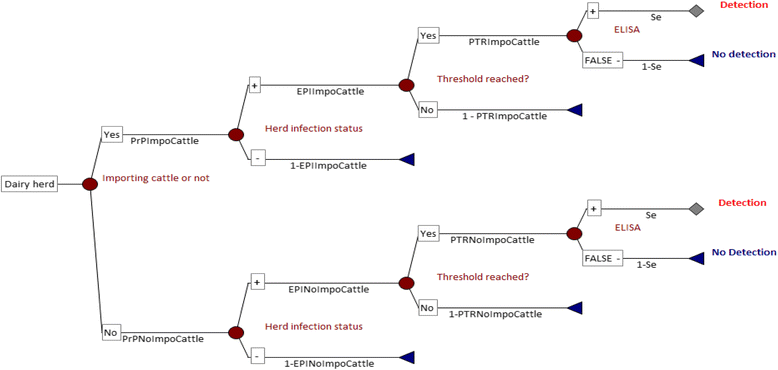Evaluation of temporal surveillance system sensitivity and freedom from bovine viral diarrhea in Danish dairy herds using scenario tree modelling
- PMID: 27323903
- PMCID: PMC4915143
- DOI: 10.1186/s12917-016-0744-2
Evaluation of temporal surveillance system sensitivity and freedom from bovine viral diarrhea in Danish dairy herds using scenario tree modelling
Abstract
Background: The temporal sensitivity of the surveillance system (TemSSe) for Bovine Viral Diarrhea (BVD) in Danish dairy herds was evaluated. Currently, the Danish antibody blocking ELISA is used to test quarterly bulk tank milk (BTM). To optimize the surveillance system as an early warning system, we considered the possibility of using the SVANOVIR ELISA, as this test has been shown to detect BVD-positive herds earlier than the blocking ELISA in BTM tests. Information from data (2010) and outputs from two published stochastic models were fed into a stochastic scenario tree to estimate the TemSSe. For that purpose we considered: the risk of BVD introduction into the dairy population, the ELISA used and the high risk period (HRP) from BVD introduction to testing (at 90 or 365 days). The effect of introducing one persistently infected (PI) calf or one transiently infected (TI) milking cow into 1 (or 8) dairy herd(s) was investigated. Additionally we estimated the confidence in low (PLow) herd prevalence (<8/4109 infected herds) and the confidence in complete freedom (PFree) from BVD (< 1/4109).
Results: The TemSSe, the PLow, and the PFree were higher, when tests were performed 365 days after BVD introduction, than after 90 days. Estimates were usually higher for the SVANOVIR than for the blocking ELISA, and when a PI rather than a TI was introduced into the herd(s). For instance, with the current system, the median TemSSe was 64.5 %, 90 days after a PI calf was introduced into eight dairy herds. The related median PLow was 72.5 %. When a PI calf was introduced into one herd the median TemSSe was 12.1 %, while the related PFree was 51.6 %. With the SVANOVIR ELISA these estimates were 99.0 %; 98.9 %, 43.7 % and 62.4 %, respectively.
Conclusions: The replacement of the blocking ELISA with the SVANOVIR could increase the TemSSe, the PLow and PFree remarkably. Those results could be used to optimize the Danish BVD surveillance system. Furthermore, the approach proposed in this study, for including the effect of the HRP within the scenario tree methodology, could be applied to optimize early warning surveillance systems of different animal diseases.
Keywords: BVD; Freedom from disease; Scenario tree; Temporal surveillance system sensitivity.
Figures

Similar articles
-
Challenges for bovine viral diarrhoea virus antibody detection in bulk milk by antibody enzyme-linked immunosorbent assays due to changes in milk production levels.Acta Vet Scand. 2015 Jun 23;57(1):32. doi: 10.1186/s13028-015-0125-z. Acta Vet Scand. 2015. PMID: 26099792 Free PMC article.
-
Stochastic simulation modeling to determine time to detect Bovine Viral Diarrhea antibodies in bulk tank milk.Prev Vet Med. 2014 Nov 1;117(1):149-59. doi: 10.1016/j.prevetmed.2014.07.007. Epub 2014 Jul 18. Prev Vet Med. 2014. PMID: 25081944
-
Temporal trends in bulk tank milk antibody ELISA and PCR test results for bovine viral diarrhoea in New Zealand pastoral dairy herds.N Z Vet J. 2021 Mar;69(2):73-82. doi: 10.1080/00480169.2020.1806756. Epub 2020 Oct 1. N Z Vet J. 2021. PMID: 32814505
-
[Perspectives on BVD eradication in Germany].Berl Munch Tierarztl Wochenschr. 2003 May-Jun;116(5-6):222-6. Berl Munch Tierarztl Wochenschr. 2003. PMID: 12784556 Review. German.
-
A scoping review of the testing of bulk tank milk to detect nonbacterial pathogens or herd exposure to nonbacterial pathogens in dairy cattle.J Dairy Sci. 2023 Aug;106(8):5636-5658. doi: 10.3168/jds.2022-22586. Epub 2023 Jun 7. J Dairy Sci. 2023. PMID: 37291033
Cited by
-
Comparison of Alternative Meat Inspection Regimes for Pigs From Non-Controlled Housing - Considering the Cost of Error.Front Vet Sci. 2018 Jun 5;5:92. doi: 10.3389/fvets.2018.00092. eCollection 2018. Front Vet Sci. 2018. PMID: 29922682 Free PMC article.
-
Base protocol for real time active random surveillance of coronavirus disease (COVID-19) - Adapting veterinary methodology to public health.One Health. 2020 Mar 28;9:100129. doi: 10.1016/j.onehlt.2020.100129. eCollection 2020 Jun. One Health. 2020. PMID: 32292815 Free PMC article.
References
-
- Brownlie J, Clarke MC, Howard CJ, Pocock DH. Pathogenesis and epidemiology of bovine virus diarrhoea virus infection of cattle. Ann Rech Vét. 1987;18:157–166. - PubMed
Publication types
MeSH terms
LinkOut - more resources
Full Text Sources
Other Literature Sources
Research Materials
Miscellaneous

